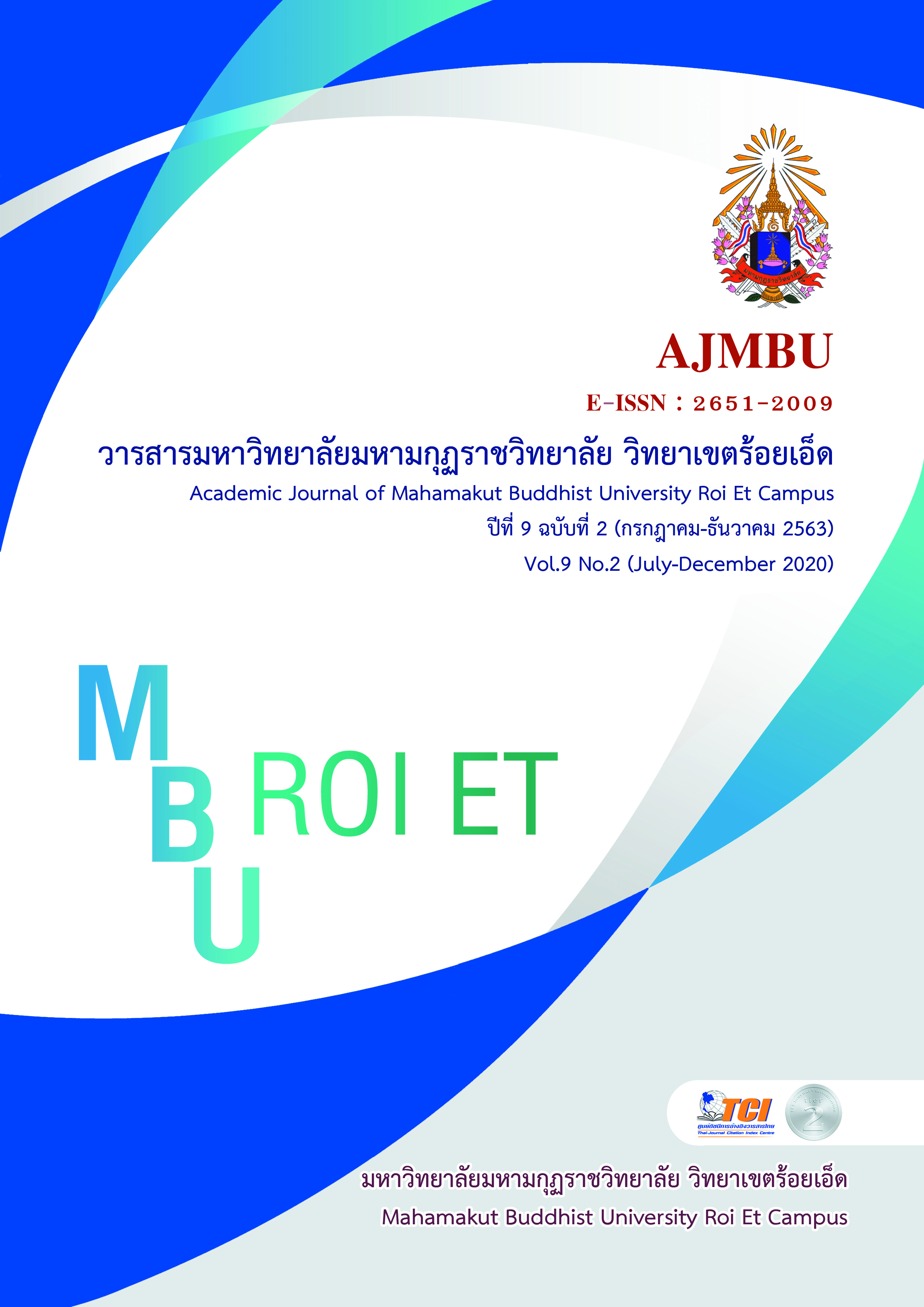The Conservation and Inheritance of the Ancestral Ritual Tradition of the Thai Chinese in Three Provinces in the Northeast
Main Article Content
Abstract
The objectives of the research were to 1)study the beliefs and rituals of the ancestors of Chinese-Thai descent in Mahasarakham, Roi Et and Kalasin. 2)Study the ways of preserving and passing on the ancestral traditions of Thai-Chinese descent in Maha Sarakham province. Roi Et and Kalasin Researchers use qualitative research methods. Using the research area of Maha Sarakham Roi Et and Kalasin Is a place to store information.
The research found that The beliefs and rituals are ancestral remembrances that continue to be important and follow. 1)Chinese New Year beliefs and rites. 2)Sheng Ming beliefs and rituals. 3)Beliefs and rituals. China The members of the Chinese-Chinese family have a strong belief and respect for the three rituals. In particular, Chinese New Year is the day when all family members have to perform rituals together. The conservation and succession of the ancient Chinese ancestry ritual in Mahasarakham province. Roi Et and Kalasin are nowadays changing their way of life to the people of the Isan traditions, values and traditions are different from the original. In order to preserve cultural traditions, it is necessary to adopt a new culture. The guidelines for conservation and succession are as follows: 1) Must be descended like a traditional Chinese family. 2) The inheritance, reception and cultural interaction. The culture of the Isan people has been adopted so that the rituals of the Chinese people can continue to be carried out in the context of the area where the Chinese people live in China and can enjoy the Isan society happily. 3) The authorities who are knowledgeable about the ritual traditions of the Chinese people are the Shrine Foundation. 4) There is support for traditional ritual activities by organizing exhibitions on Chinese culture and traditions. Whether it is a print media such as a ritual book about the Thai people of Chinese descent. Online publishing Internet For those who are interested in the search and learn.
Although some of the rituals have changed somewhat in the context of the area, Chinese-speaking Thais in the research area They are very important. This is to help conserve and inherit the ritual sacrifice of the ancestors so well that traditional rituals are with the Chinese people for a long time.
Article Details
References
ณรงค์ พ่วงพิศ. (2525). สายสัมพันธ์ระหว่างชาวจีนอพยพกับราชสำนักไทย. คนจีน 200 ปี ภายใต้พระบรมโพธิสมภาร (ภาค 2). กรุงเทพมหานคร : สหมิตรการพิมพ์.
นารีรัตน์ ปริสุทธิวุฒิพร. (2548). โครงการวิจัย เรื่อง คนจีนกับการขยายตัวของเมืองบริเวณลุ่มน้ำชี. กรุงเทพมหานคร : สำนักงานกองทุนสนับสนุนการวิจัย.
พงษ์ทัช จิตวิบูลย์และปัญญา เทพสิงห์. (2560). ประเพณีเช็งเม้ง : คุณค่าที่มีต่อสังคมในเมืองหาดใหญ่. วารสารมหาวิทยาลัยนครพนม. 7(1). 72-80.
พงษ์ทัช จิตวิบูลย์. (2559). ประเพณีเช็งเม้ง : คุณค่าต่อสังคมท่ามกลางการเปลี่ยนแปลงในเมืองหาดใหญ่. วิทยานิพนธ์ปริญญาศิลปศาสตรมหาบัณฑิต สาขาวิชาพัฒนามนุษย์และสังคม. มหาวิทยาลัยสงขลานครินทร์.
พรพรรณ จันทโรนานนท์. (2550). ชาวจีนในไทย. วารสารศิลปวัฒนธรรม. 29(2). 158-169.
ภัทรภร สุวรรณจินดา และหลี่ เหรินเหลียง. (2559). การปรับตัวทางวัฒนธรรมของคนไทยเชื้อสายจีน: กรณีศึกษาคนไทยเชื้อสายจีนย่านเยาวราช. วิทยานิพนธ์ศิลปศาสตรมหาบัณฑิต สาขาวิชาการบริหารการพัฒนาสังคม. สถาบันบัณฑิตพัฒนบริหารศาสตร์.
เรือนแก้ว ภัทรานุประวัติ. (2551). ความต่อเนื่องและการเปลี่ยนแปลงของศาลเจ้าจีนในจังหวัด สมุทรสงคราม. กรุงเทพมหานคร : มหาวิทยาลัยหอการค้าไทย.
วันดี สันติวุฒิเมธี. (2545). กระบวนการสร้างอัตลักษณ์ทางชาติพันธุ์ของชาวไทใหญ่ชายแดนไทย-พม่า : กรณีศึกษาหมู่บ้านเปียงหลวง อำเภอเวียงแห จังหวัดเชียงใหม่. วิทยานิพนธ์สังคมวิทยาและมานุษยวิทยามหาบัณฑิต(มานุษยวิทยา). คณะสังคมวิทยาและมานุษยวิทยา : มหาวิทยาลัยธรรมศาสตร์.
สุชาดา ตันตสุรฤกษ์. (2532). โพยก๊วน : การส่งเงินกลับประเทศโดยชาวจีนโพ้นทะเลในประเทศไทย. กรุงเทพมหานคร : สถาบันเอเชียศึกษา จุฬาลงกรณ์มหาวิทยาลัย.
Qin Hua. (2559). การศึกษาประเพณีสารทจีนของชาวไทยเชื้อสายจีนในเขตเทศบาลเมืองชลบุรี จังหวัดชลบุรี. วารสารวิชาการมนุษยศาสตร์และสังคมศาสตร์ มหาวิทยาลัยบูรพา. 24(45). 125-137.


